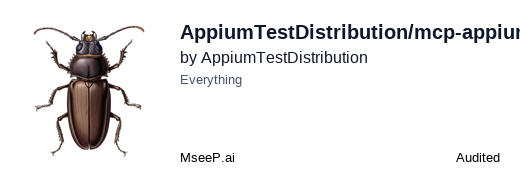About
A lightweight MCP server that provides documentation resources and code‑generation tools for common Appium mobile gestures such as tap, swipe, scroll, pinch/zoom, long press, drag‑and‑drop, and double tap in JavaScript or Java.
Capabilities

Overview
The MCP Appium Gestures server bridges the gap between natural‑language AI assistants and mobile automation tooling. It exposes a rich set of documentation resources and code generation tools for the most common Appium gestures, allowing developers to request high‑quality, language‑specific snippets directly from Claude or any MCP‑compatible client. By abstracting the intricacies of Appium’s API, this server lets AI assistants act as real‑time coding partners, dramatically reducing the time spent hunting for syntax or remembering method signatures.
Problem Solved
Writing and debugging Appium scripts can be tedious, especially for beginners who must juggle multiple languages (JavaScript, Java) and a vast array of gesture commands. A typical workflow involves searching the Appium docs, copying snippets, and then tweaking them for context—often leading to errors or inconsistent patterns. The MCP Appium Gestures server eliminates this friction by offering on‑demand, contextually relevant code and documentation. Developers no longer need to leave their AI chat or IDE; the assistant can generate ready‑to‑paste code snippets that respect language conventions, element references, and coordinate handling.
Core Capabilities
- Gesture Documentation – Accessible via URIs, the server hosts concise guides for tap, swipe, scroll, pinch/zoom, long press, drag‑and‑drop, and double tap. These resources include typical use cases, parameter explanations, and best practices.
- Code Generation Tools – Three primary tools (, , etc.) produce language‑specific Appium commands. Parameters such as element IDs, coordinates, and duration are validated automatically, ensuring the output is syntactically correct.
- Multi‑Language Support – Both JavaScript (WebdriverIO v9+ and below) and Java clients are supported, allowing teams with heterogeneous codebases to benefit from the same AI‑powered workflow.
Real‑World Use Cases
- Rapid Prototyping – A QA engineer can ask the assistant to generate a swipe sequence for onboarding screens, receiving JavaScript code instantly.
- Cross‑Platform Testing – A developer maintaining parallel iOS and Android tests can request Java snippets for drag‑and‑drop, ensuring consistency across platforms.
- Onboarding New Team Members – Instructors can use the gesture resources to teach students how to interact with mobile elements without writing boilerplate code.
Integration into AI Workflows
The server follows the MCP specification, making it plug‑and‑play with Claude Desktop, Cursor, or any custom client. Once configured, a single block in the chat can produce complex gesture code. The assistant can also fetch documentation via , allowing developers to read guidelines without leaving the conversation. Because the server operates over stdio or SSE, it scales from local experimentation to remote CI pipelines.
Unique Advantages
- Zero Boilerplate – Code generation eliminates repetitive typing and reduces syntax errors.
- Consistent Best Practices – The documentation URIs enforce a standard approach to gestures, helping teams adopt uniform patterns.
- Extensibility – New gesture tools or languages can be added without changing client logic, thanks to the modular MCP architecture.
In summary, the MCP Appium Gestures server transforms AI assistants into powerful mobile automation partners, streamlining gesture implementation and documentation access across languages and platforms.
Related Servers
MarkItDown MCP Server
Convert documents to Markdown for LLMs quickly and accurately
Context7 MCP
Real‑time, version‑specific code docs for LLMs
Playwright MCP
Browser automation via structured accessibility trees
BlenderMCP
Claude AI meets Blender for instant 3D creation
Pydantic AI
Build GenAI agents with Pydantic validation and observability
Chrome DevTools MCP
AI-powered Chrome automation and debugging
Weekly Views
Server Health
Information
Explore More Servers
Google Cloud Run MCP Server
Deploy AI-generated code to Cloud Run effortlessly
XTB MCP Server
Automated XTB Quantum Chemistry Input Generation
Smithery Cli MCP Server
Discover, configure, and install MCP servers from the command line
Weather MCP Server
Real‑time US weather via the National Weather Service API
ME-MCP
Personal MCP server for resume sharing and Discord messaging
Podbean MCP Server
Manage podcasts with natural conversation